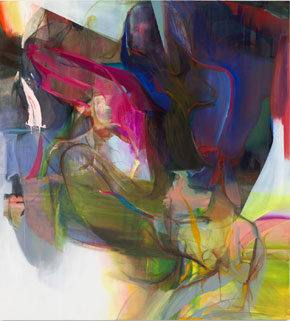4.22.24 — Big Girls
Grace Carney cannot get enough of women. Her show’s title insists on it, thrice over, with “girlgirlgirl.” You just may not notice them right away or see them all at once, at P.P.O.W. through February 24, and excuse me for another late post. She deserved your and my fuller attention.
Her stained colors command attention all by themselves, at least for a moment, and continue to reward attention after that. They recall an era when color-field painting alone sufficed to go big. Still, they temper their breathless good cheer with female bodies in the present. They invite one to ask when drawing becomes painting and flowing paint becomes drawing once again. 
More and more galleries have been pursuing diversity by looking back. They keep returning to postwar abstraction and the women who made it, all the more so if those women suffered neglect along the way. Just this year, a gallery called its winter group exhibition “Perseverance.” What sets these artists apart, and can gender alone explain their neglect? After all, Joan Mitchell and Helen Frankenthaler made history while inventing color-field painting, taking Abstract Expressionism to a new level, and historians have taken note just fine. After all, too, trends do become stale, so why look back?
A little skepticism is all the more important when the artist is not neglected but just breaking through. Carney, now at a Tribeca gallery with a history of its own, received her MFA as recently as 2022. One could almost read the show’s title as “You Go Girl.” Is the going now easy? At what point does the back and forth between realism and abstraction become itself a cliché, a means of mythmaking twice over? Carney, though, sees them as far more than myths.
 The artist combines lots of color with ample white space, giving her shapes room to expand. Pours and brushwork themselves expand outward in translucent swirls. They suggest Morris Louis, but the light colors never run together to the point that they become his darker veils, and symmetry is out of the question. Carney is asking not for late Modernism’s rigor but only its paint. Her overlapping marks violate an older generation’s demands for both flatness and space. They have to do so, to let the images emerge as women.
The artist combines lots of color with ample white space, giving her shapes room to expand. Pours and brushwork themselves expand outward in translucent swirls. They suggest Morris Louis, but the light colors never run together to the point that they become his darker veils, and symmetry is out of the question. Carney is asking not for late Modernism’s rigor but only its paint. Her overlapping marks violate an older generation’s demands for both flatness and space. They have to do so, to let the images emerge as women.
She is just as serious about the body. She treats big girls not, as so often in painting now, as characters in a mythic narrative, but rather as figure studies. They twist and turn freely, as if to hide, although faces appear as well. Their closeness to the picture plane may come closest of all to Joan Semmel in her nineties. Maybe Carney is not satisfied with the appeal of the emerging artist after all. I look forward to what comes next, after the good cheer is gone.
Eddie Martinez masks everything about his figures but their faces, as “Wavelengths,” at Mitchell-Innes & Nash through March 9. His Whiteouts start with group portraits in the Brooklyn community he knows best, much like Henry Taylor. Then he paints over them, like his Flower Pots, with plenty of white. White can surround a face like a halo. Black and color still peek through, in a contrast that recalls the youngest of the old Abstract Expressionists, Richard Pousette-Dart, as much as acts of erasure. They express the effacement of people of color, but also their pleasure in just hanging out.
Read more, now in a feature-length article on this site.